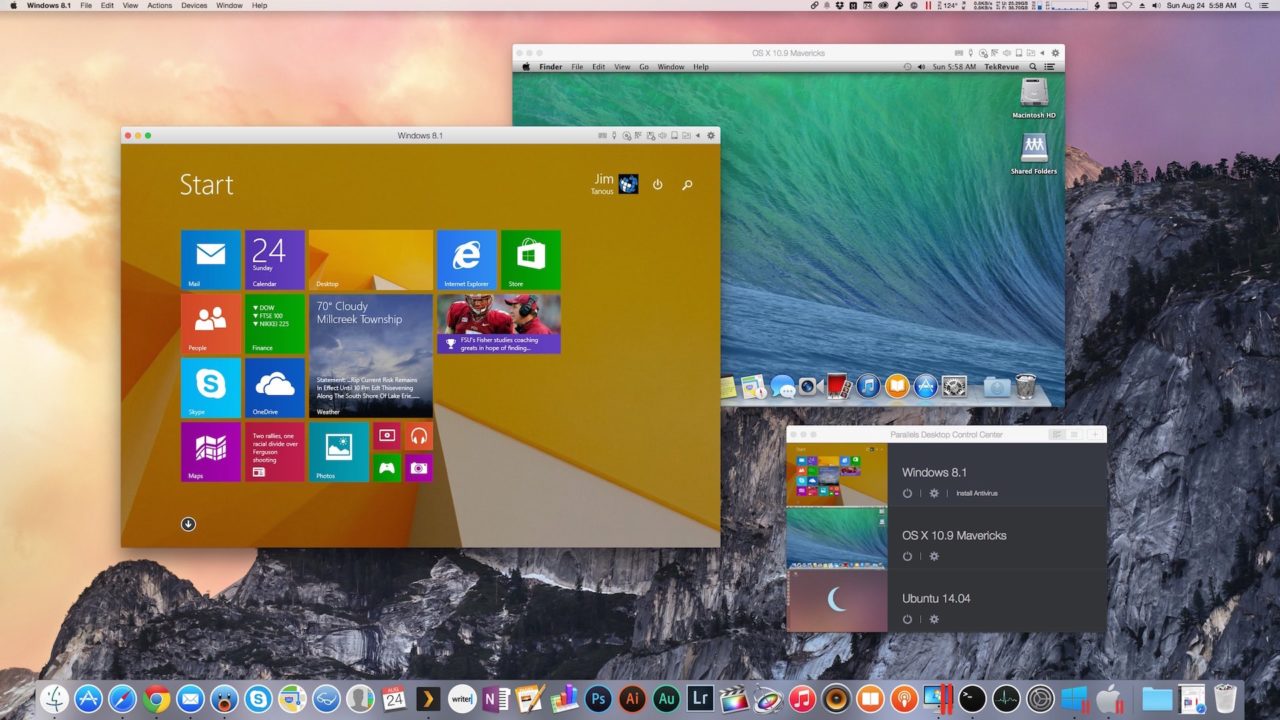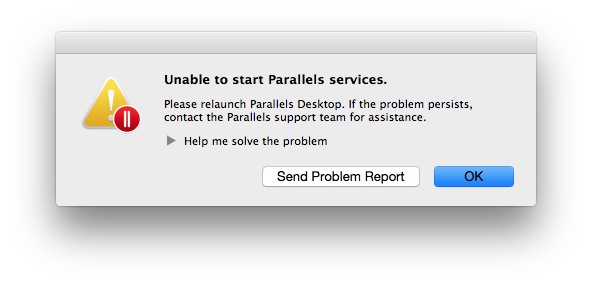Parallels Desktop 10 Puts Emphasis on Features Over Performance

Upgrade Controversy
Last week, just as Parallels 10 was introduced, Apple released OS X Yosemite Developer Preview 6. Parallels Desktop 9, which had worked virtually flawlessly on all of the preceding developer previews, suddenly stopped working in Yosemite.
A workaround was introduced, but many users reported that it didn’t solve the issue for them. Parallels acknowledged the issue in a support article, but made no commitment to fix it, stating the following and encouraging users to upgrade to Parallels 10 (emphasis ours):
The Development team is aware of this issue still being presented in Parallels Desktop 9, and a fix may be included in future Parallels Desktop 9 updates.
Update: as noted below, Parallels has now updated the language in its support article to clarify the company’s position that a fix for Parallels Desktop 9 will be released. It now reads (as of 2014-08-27):
The Development team is aware of this issue still being presented in Parallels Desktop 9, and a fix will be included in the next Parallels Desktop 9 update. Please keep your copy of Parallels Desktop 9 up-to-date. To enable automatic updates please right click on Parallels Desktop icon -> Preferences… -> Check for Updates.
This has unsurprisingly angered many Parallels 9 users, who understandably view the situation (and its timing) as an underhanded way to force users to upgrade. While some user theories are a bit absurd, such as those suggesting that Parallels intentionally broke version 9 on Yosemite, the company’s lack of commitment to fixing software that was released less than a year ago is disconcerting.
We implore the company to fix Parallels 9 on OS X Yosemite
This situation brings up an interesting debate on the broader industry’s move to subscription software. Parallels understandably needs steady revenue to continue development of its products, and users expect support for Apple’s new relatively rapid OS X release cycle. Other companies, like Microsoft and Adobe, have responded to similar situations by introducing a subscription model, where users pay a single monthly or yearly fee for ongoing access to regularly updated software. With compatibility and support issues hampering complicated virtualization software like Parallels, it’s not unfair to say that Parallels Desktop has moved to a de facto subscription model as well, with upgrades required each year to ensure proper functionality (or functionality of any kind at all).
Subscription models aren’t necessarily a bad thing. Here at TekRevue, for example, we happily subscribe to both Office 365 and Creative Cloud, because we recognize the benefits of the subscription model and need indefinite access to the latest versions of both products anyway. The same could be said of virtualization software like Parallels Desktop, but the difference is that Parallels still markets the software as a traditional standalone product, and it’s unfair to users when situations such as the current one arise and they’re faced with the choice of upgrading to Yosemite or keeping Parallels 9 working.
Parallels is no stranger to subscriptions; the company offers its Parallels Access remote service for a $20 yearly fee. But Parallels must now make a choice with regard to Parallels Desktop: either continue to support older versions of the software for a reasonable time (and 1 year, as it is here with Parallels 9, is arguably not reasonable), or be upfront with customers and move to a subscription model. There’s risk to that approach, of course, especially if competitor VMware chooses to keep Fusion as a perpetually licensed product, but it would represent a more honest way of dealing with customer expectations if the company truly doesn’t want to provide long-term support to previous versions of the software. The sooner Parallels makes this choice, the better, because there’s no question that Apple is going to continue to release yearly updates to OS X, and those updates are sure to break future versions of Parallels Desktop.
Any choice Parallels makes, however, should apply to future products only, and we implore the company to fix Parallels 9 on Yosemite. Customers deserve support that lasts longer than a year, and Parallels can’t claim that they didn’t anticipate that a new version of OS X would be released this fall. To ignore the issue and force its customers to choose between Parallels 9 (software that many have owned for far less than a year), upgrading to Yosemite, or forking over $50 so soon after their initial purchase would be unconscionable.
Update (11:30 AM EDT): Parallels has stated that they will update Parallels Desktop 9 for Yosemite, but they can’t guarantee that it will work for the remainder of the developer builds, just the final public version. Here is the statement provided to TekRevue:
In terms of Yosemite support in PD9 – we will support it – that’s our commitment. When a pre-release operating system is being developed, every new build creates changes that can cause issues with any software. Currently we are trying to support Apple’s developer builds of Yosemite the best we can. We are aware of the issue with the developer builds of Yosemite and are working on it. Parallels closely follows Apple development and is almost always first to support latest innovations from Apple. In the meantime, we anticipate releasing a Parallels Desktop 9 update in early September that will address issues related to Yosemite. In terms of subscription models, we are definitely considering.
Conclusion
The unpleasantness of the upgrade controversy aside, Parallels Desktop 10 is a feature-focused update that makes using VMs with the latest operating systems from Apple and Microsoft a slick and easy experience. That said, you won’t find much in the way of performance improvements if you’re coming from Parallels 9, but those on older versions of the software, as well as those who want tight integration between OS X and Windows, will likely be happy with Parallels 10’s new features.
Users running Parallels Desktop 8 or 9 can upgrade now to Parallels Desktop 10 for $49.99. Anyone who bought Parallels 9 after August 1, 2014 can get a free upgrade to Parallels 10 via the company’s “Tech Guarantee” program. If you’re new to Parallels, or running a version that’s not eligible for upgrade pricing, the full version of Parallels Desktop 10 will be available today, August 26, for $79.99.
Parallels competitor VMware Fusion has released a series of “technology preview” builds over the past few months, but there’s no word yet on when Fusion 7 will see a public debut. Once it’s available we’ll revisit the benchmarks above to compare performance between the two products. Until then, if there are any specific benchmarks you’d like to see tested, please let us know in the comments. We’ll do our best to accommodate your requests.



















6 thoughts on “Parallels Desktop 10 Puts Emphasis on Features Over Performance”
https://www.vmware.com/products/fusion/features.html?src=WWW_Fusion_US_HPBanner_Tier1_3_Features_Promo
Parallels seriously keep ignoring paying customers with their greedy business practices. How does a customer who have bought THEIR software have to pay another $50 to upgrade to get a working copy of Parallels? Bought Parallels 9 right before OSX 10.10’s first DP. Parallels 9 kept working up until DP 3. Of course they will hide the fact that there is a Parallels 10 in the works, and then expect another $50 from a paying customer, which is the only way to get it to do work again, which is a HELL NO.
Can’t even get a refund, so I hope my Charity somehow went into their more self marketing endeavours like Ice bucket challenges, etc.
Don’t buy!
I definitely understand your concern. Note, however, that we brought this issue to the attention of Parallels and they have promised to fix Parallels 9 for the final version of Yosemite. See the discussion of this on the third page of this review. Thanks for visiting!
As a developer I KNEW I should have stuck to VB or VMWare, but I really wanted to give Parallels go. But hey we all make mistakes.
I performed some benchmarks a few years ago comparing VirtualBox to Parallels 8 and Fusion 5. Once Fusion 7 is released, I’ll pit VirtualBox against it and Parallels again and report the results here.
VMWare Fusion also looks definitely promising. In terms of performance, the Fusion Tech Preview seems to be on par with Parallels 10 (I checked Java EE application server startup time and Windows / Office document operations, but this isn’t a professional benchmark). Although the final product is not released yet, Fusion does not seem to have as complete DirectX support as Parallels has, but that’s not an issue for me. Fusion also has Open Virtualization Format export from the GUI.
Another pro for Fusion is the pricing: VMWare usually has very nice offers around black friday. And VMWare licensing allows usage on all the home Macs with one single license. What’s specially disgusting about Parallels is the price difference: in US, the upgrade is 49.99 USD, in Europe it is 59 USD + V.A.T. (The V.A.T. is acceptable, the higher basis price isn’t. Yes, this isn’t a big amount of money, but this is about principles.)
The features of Parallels 10 seem to be cool, the one click disk space reclaim function works for both Windows and Linux guests – for VMWare Fusion I had to manually fill the virtual disk with zeroes and use a command line utility to reclaim unused space.
The big jump in performance was in versions Parallels 8->9 and VMWare Fusion 5->6 (my application server startup reduced from 4.5 to 3.5 minutes any my Windows guest also feels snappier) – Parallels 10 offers nice increases in the specs but I did not see any real improvements (I think that complies to conclusion of this Article).
So I’m considering to upgrade to Parallels 10 or Fusion 7 from my current Parallels 8. I’ll definitely wait for the final Fusion 7 and the TekRevue report and then decide :)